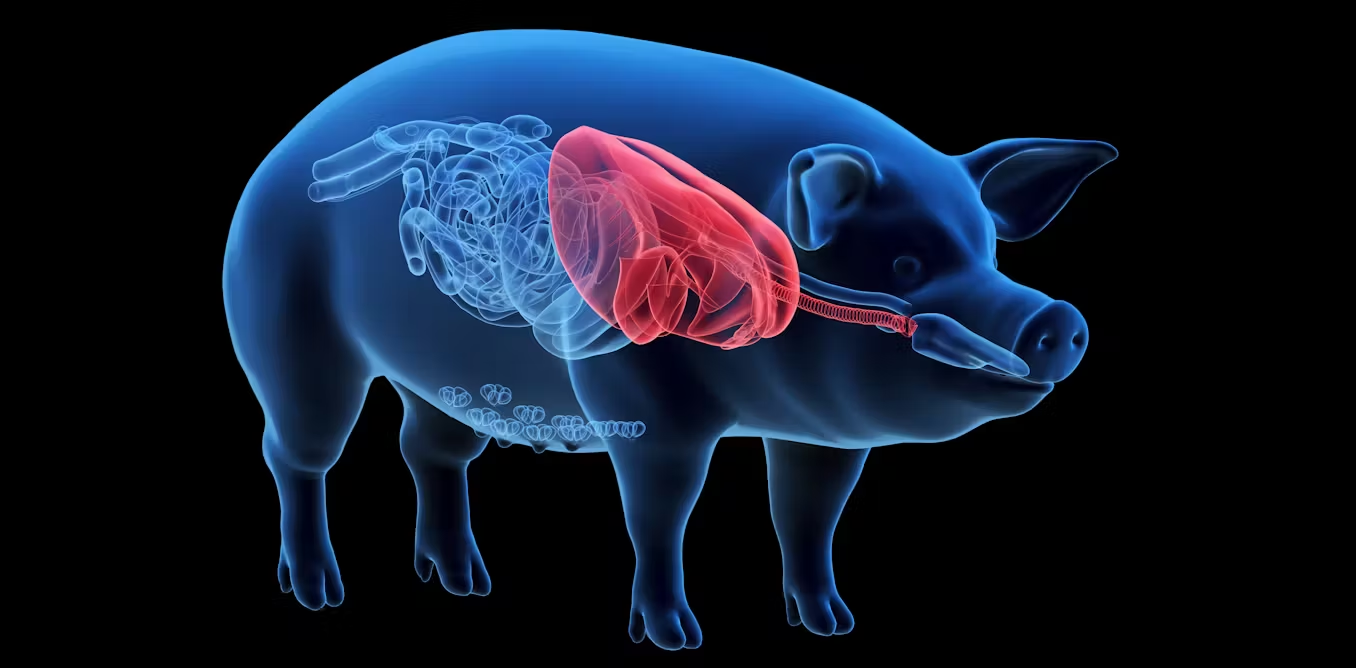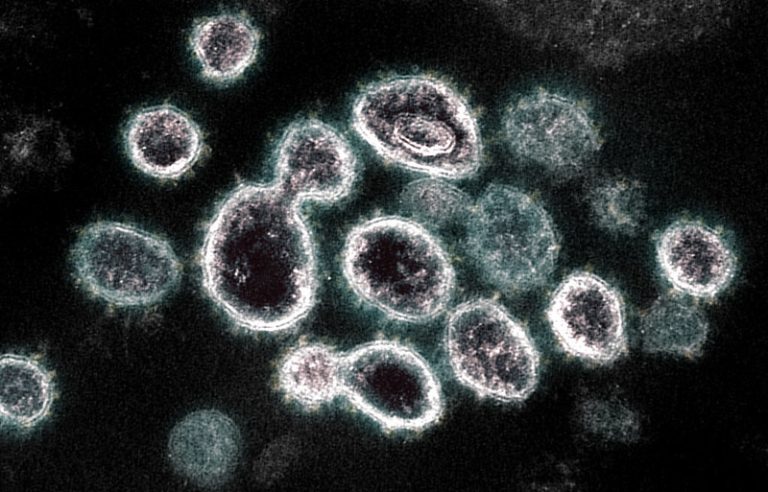News
Xenotransplantation: and the pig?
Xenotransplantation in humans is the subject of one announcement after another. This involves transplanting an organ or tissue from a genetically modified animal into a human, to alleviate the shortage of human organs. The “new genomic techniques” are used to genetically modify donor animals. Does the use of these techniques raise new questions of animal ethics?

The US Food and Drug Administration (FDA) has just authorised clinical trials of kidney transplants from genetically modified (GM) pigs in patients suffering from kidney failure for which there is no treatmenti. We can read in a small article in Le Mondeii that the pigs are “produced” by two American companies, United Therapeutics and eGenesis.
The reification of animals for the benefit of the human species continues in the wake of intensive livestock farming. So why not take a look at the animals themselves?
In Switzerland, an independent committee, the Federal Ethics Committee on Non-Human Biotechnology, commissioned an expert report asking whether “recent developments in the field of xenotransplantation after the introduction of genome editing technologies” raise new ethical questions for the animal. This report replied, in December 2024iii, that there were no new qualitative issues raised by these new tools. However, it points out, “contemporary biotechnological developments must be taken as an opportunity to discuss existing ethical issues in an urgent and intensified manner, particularly regarding the significance of animals’ moral standing. The lack of consideration of animal-related aspects and the neglect of current developments and the state of the art of animal ethics in the recent discussion about xenotransplantation is a scientific, ethical, and political issue because animals are most negatively affected by xenotransplantation”.
Xenotransplantation, “new genomic techniques” and “cloning“
Biotechnological tools, such as nucleases (enzymes) like Crispr/Cas, are increasingly being used to genetically modify pigs so that they produce organs available for these transplants. Primates have long been the preferred donors for xenotransplants, as they are the most similar mammals, immunologically speaking, to humans. However, for ‘manufacturers’, pigs are now preferable. It is, they say, more fertile and, in terms of size, anatomy and physiology, its organs are similar to those of humans.
The fact remains that humans are not pigs. The pig therefore needs to be genetically modified if the xenotransplant is to have any chance of success. Specific pig genes (which are recognised by antibodies naturally present in humans, which would cause graft rejection) have to be deleted and human transgenes (which facilitate graft acceptance) inserted. The growth hormone receptor geneiv is also inactivated so that the organ does not undergo undesirable rapid growth in the animal. These modifications to the animal’s genes can be carried out by transgenesis or mutagenesis using nucleases. The pig must also be free from specific pathogens. The “new genomic techniques” (NGT) would make it possible to prevent viral transmission between species. For example, the pig supplied by eGenesis has undergone 69 genetic modifications, many of which involve inactivating a retrovirus endogenous to the pig (viral sequences integrated into the genomev) that would become dangerous if transmitted to humans via the graftvi !
All these modifications are made in vitro to a single female pig cell obtained in a special way. A somatic cell with very little differentiation is extracted from an adult female and the nucleus is removed. The nucleus is then inserted into an enucleated ovum taken from another sow. Genetic manipulation is carried out on the cell thus obtained. This GM cell divides several times. The resulting cells, which share the same genetic heritage, are separated and each produces a GM embryo. These embryos are implanted in a third sow, the surrogate mother. She will give birth to piglets carrying the genetic modificationsvii. This technique is known as “somatic cell nuclear cloning”. This is the technique used for the sheep Dolly.
Health problems and pig welfare
For the last 20 years or so, in the field of xenotransplantation, the medico-technical debate has dominated the debate on human ethics and, even more so, the debate on animal ethics. In Switzerland, the Federal Ethics Committee on Non-Human Biotechnologyviii points to the total absence of reflection on animal ethics. Yet animal ethics has developed around concepts such as animal dignity and integrity, based on scientific research into consciousness in animalsix, and going beyond the simple traditional concept of animal welfare, which is highly subjective.
As the swiss expert reportx tells us, “certain modifications could have negative side effects on the health and welfare of GE animals. The more the animal genome is interfered with, the higher the risk of unforeseen interactions between the various interventions”.
The use of the new genetic tools would, according to the promoters of these xenografts, limit off-target effects, i.e. effects on other organs of the pig. However, the same report states: “While this method [CRISPR/Cas9] is generally considered to be much more efficient and specific compared to other approaches, any accurate, definitive, quantitative estimation of the efficiency of CRISPR is difficult to find, as estimates vary considerably and are affected by many factors, including the nature of the target site and the CRISPR molecule used”.
The technique known as “nuclear cloning” used to give birth to these animals is not without consequences for their health and well-being either. The Swiss report states that “the live birth rate (live born animals per transferred embryos) in pigs persists at a value of circa 6% and a range between 0.6% and 7%. Some of the clones born alive suffer from health-related strains, which can be lethal “.
The report acknowledges that the combination of NGTs and the production of embryos by “nuclear cloning” makes it possible to minimise the number of laboratory animals (e.g. for testing off-target effects), but that, from the point of view of animal ethics, the question arises as to whether this combination is sufficiently safe for pigs, i.e. neither dangerous nor suffering.
The concept of “animal dignity“
In Swiss regulations, the concept of ‘animal dignity’ is defined as the “inherent worth of the animal that has to be taken into account when handling it”. This inherent worth refers to “the claim that we should behave morally toward them for their own sake. Hence, moral agents would not behave morally toward animals if they only value them based on their aesthetic, culinary, social, or other instrumental values and treat them well accordingly. Every being that has an inherent worth thus has to be respected independently of its benefit to others“.
Consequently, the report adds that “any harm must be justified on morally relevant grounds […] in particular if pain, suffering or harm is inflicted on the animal, if it is exposed to anxiety or humiliation, if there is [a] major interference with its appearance or its abilities, or if it is excessively instrumentalized”.
In the present case, the rearing conditions take account of devices to avoid any contamination of the pigs by pathogenic micro-organisms that could be transmitted to the organs to be grafted. For example, piglets are born by caesarean section to avoid any contact between the piglets and both the sow and sow’s milk, and piglets are reared in sterilised islets and fed a sterilised feed. The Swiss report is explicit: “it is doubtful whether [these] conditions will satisfy the natural behaviors and needs of pigs, whose broad behavioral repertoire and complex cognitive and emotional abilities are comparable to those of dogs and chimpanzees”. In other words, there is the problem of significant damage to animal dignity.
Non-sentient damage affecting the animal’s appearance or capacities is observable. They are significant (particularly as regards all the organs) in the case of these GM pigs and, the report continues, the instrumentalisation of pigs is at its maximum.
As a result of these sensitive or non-sensitive prejudices, the Swiss report tells us that respect for animal dignity should prohibit these practices.
Human interests and animal ethics are therefore weighed against each other. The same applies to the Enlarged Board of Appeal of the European Patent Office (EPO)xi in the case of animal-human chimeras. For the time being, this remains a debate between experts, but it is positive to note that the subject of animal ethics is beginning to be taken into account.
The Swiss report goes on to explain that “while xenotransplantation affects important human interests such as quality of life and health, it is difficult to determine whether and, if so, for how long the xenografts will function in the human body. Data on the quality of life of xenotransplant recipients is also not yet available. Even if the dignity of creature approach is a hierarchical approach in which human interests count more than those of animals, human interests do not always outweigh those of animals“.
The same report adds that “animals are regarded as an economic and scientific resource, whereby they are systematically institutionalized and legally harmed and killed. This presents a profound moral problem. Instead of claiming a relationship of morally condemnable instrumentalization or exploitation with animals, it is also possible to understand animals as friends, neighbors, fellow creatures, or companions (as can be the case with cats and dogs) or even fellow citizens with whom we should be able to share the resources of this planet and live together with as little conflict as possible“.
This report is surprising and, while it does not settle the question, it concludes that “due to the international interdependence of science, a comparative global study of ethical xenotransplantation regulations and their relation to the current state of animal ethics would be beneficial”.
In the case of xenotransplants, concerns about animal ethics are well-founded and open up an even wider field of philosophical reflection: as we instrumentalise all living things (plants, animals, micro-organisms), what anthropological future are we heading for? What will remain of our original link with nature?
i United Therapeutics Corporation, « United Therapeutics Corporation Announces FDA Clearance of its Investigational New Drug Application for the UKidney Xenotransplantation Clinical Trial », 3 février 2025.
ii Le Monde, Science et Médecine, p.3, 12 February 2025 (in French) .
iii Samuel Camenzind, « Xenotransplantation in the Age of Genome Editing: Results From the Expert Report for the Federal Ethics Committee on Nonhuman Biotechnology With a Special Focus on Animal Ethics », Xenotransplantation, Volume31, Issue 6, November/December 2024.
iv A molecule inserted into the membrane of certain cells which binds the hormone, triggering reactions in the cell.
v Annick Bossu, « Vaccins à ARN messager : un peu de lumière sur l’ombre », Inf’OGM, 21 April 2022 (in French).
vi eGenesis, « Xenotransplantation ».
Alex Knapp, « The Startup Behind The First Pig-Human Kidney Transplant Is Targeting Hearts And Livers Next », Forbes, 2 avril 2024.
According to CEO Mike Curtis, eGenesis has raised $291 million in venture capital to date. It aims to take its gene-editing technology for kidney, liver and heart transplants to the clinical trial stage within the next two years, making it a key player in a market estimated to be worth around $15 billion.
vii Samuel Camenzind, « Xenotransplantation in the Age of Genome Editing: Results From the Expert Report for the Federal Ethics Committee on Nonhuman Biotechnology With a Special Focus on Animal Ethics », Xenotransplantation, Volume31, Issue 6, November/December 2024.
viii Ibid.
ix See for example the works of Inrae: « Animal consciousness: new knowledge », 12 May 2017.
x Samuel Camenzind, « Xenotransplantation in the Age of Genome Editing: Results From the Expert Report for the Federal Ethics Committee on Nonhuman Biotechnology With a Special Focus on Animal Ethics », Xenotransplantation, Volume31, Issue 6, November/December 2024
xi Denis Meshaka, « The European Patent Office outlines a fragile ethical frontier », Inf’OGM, 20 mars 2025.










